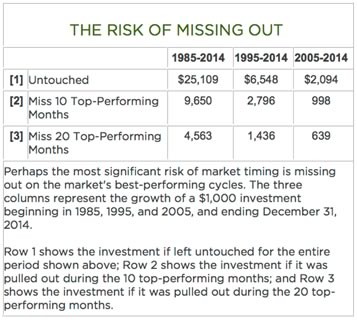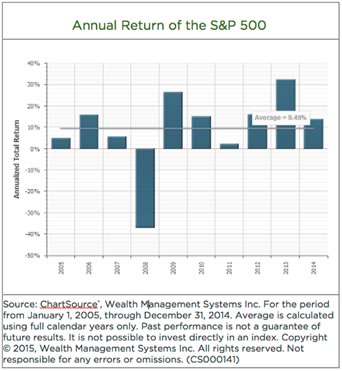Find out about the potential risks of market timing versus a buy-and-hold investment strategy
Market timing is an investing strategy in which the investor tries to identify the best times to be in the market and when to get out. Market timing is often used by brokers, financial analysts, and mutual fund portfolio managers who rely upon forecasts, market analysis, and their predictive talents to guess the optimal time to buy and sell. Market timing strategies range from putting 100% of assets in or out of one asset class to allocating among a variety of assets based on market performance expectations.
A big risk of market timing is missing out on the best-performing market cycles; missing even a few months can substantially affect portfolio earnings. Moreover, guessing the market’s timing is not easy, and even professional money managers, on average, have not been able to beat the overall stock market (as represented by the S&P 500 index).
For individual investors, a better alternative over the long run may be a buy-and-hold strategy. But a buy-and-hold strategy should still include regular portfolio checkups and balancing as necessary. Time horizon is particularly important when determining asset choices, with riskier investments generally better suited for longer-term goals. A financial advisor can help you determine an asset allocation suitable to your goals. Read more.
Sports commentators often predict the big winners at the start of a season, only to see their forecasts fade away as their chosen teams lose. Similarly, market timers often try to predict big wins in the investment markets, only to be disappointed by the reality of unexpected turns in performance. It’s true that market timing sometimes can be beneficial for seasoned investing experts (or for those with a lucky rabbit’s foot); however, for those who do not wish to subject their money to such a potentially risky strategy, time — not timing — could be the best alternative.
What Is Market Timing?
Market timing is an investing strategy in which the investor tries to identify the best times to be in the market and when to get out. Relying heavily on forecasts and market analysis, market timing is often utilized by brokers, financial analysts, and mutual fund portfolio managers to attempt to reap the greatest rewards for their clients.
Proponents of market timing say that successfully forecasting the ebbs and flows of the market can result in higher returns than other strategies. Their specific tactics for pursuing success can range from what some have termed “pure timers” to “dynamic asset allocators.”
Pure timing requires the investor to determine when to move 100% in or 100% out of one of the three asset classes — stocks, bonds, and money markets. Investment in a money market fund is neither insured nor guaranteed by the U.S. government, and there can be no guarantee that the fund will maintain a stable $1 share price. The fund’s yield will vary. Perhaps the riskiest of market timing strategies, pure timing also calls for nearly 100% accurate forecasting, something nobody can claim.
On the other hand, dynamic asset allocators shift their portfolio’s weights (or redistribute their assets among the various classes) based on expected market movements and the probability of return vs. risk on each asset class. Professional mutual fund managers who manage asset allocation funds often use this strategy in attempting to meet their funds’ objectives.

Use Time to Your Advantage
If you’re not a professional money manager, your best bet is probably to buy and hold. Through a buy-and-hold strategy, you take advantage of the power of compounding, or the ability of your invested money to make money. Compounding can also help lower risk over time: As your investment grows, the chance of losing the original principal declines.

Regular Evaluations Are Necessary
Buy and hold, however, doesn’t mean ignoring your investments. Remember to give your portfolio regular checkups, as your investment needs will change over time. Most experts say annual reviews are enough to ensure that the investments you select will keep you on track to meeting your goals.
Normally a young investor will probably begin investing for longer-term goals such as marriage, buying a house, and even retirement. The majority of his portfolio will likely be in stocks and stock funds, as history shows they have offered the best potential for growth over time, even though they have also experienced the widest short-term fluctuations. As the investor ages and gets closer to each goal, he or she will want to rebalance portfolio assets as financial needs warrant.
This hypothetical investor knows that how much time is available plays an important role when determining asset choice. Most experts agree that a portfolio made up primarily of the “riskier” stock funds (e.g., growth, small-cap) may be best for those saving for goals more than five years away; growth and income funds and bond funds might be the main focus for investors nearing retirement or saving for shorter-term goals; and investors who see a possible need for cash in the near future might consider a portfolio weighted toward money market instruments.2 Remember, though, that even those enjoying retirement should consider the historical inflation-beating benefits of stocks and stock mutual funds, as people often live 20 years or more beyond their last official paycheck.
Time Is Your Ally
Clearly, time can be a better ally than timing. The best approach to your portfolio is to arm yourself with all the necessary information, and then take your questions to a financial advisor to help with the final decision making. Above all, remember that both your long- and short-term investment decisions should be based on your financial needs and your ability to accept the risks that go along with each investment. Your financial advisor can help you determine which investments are right for you.
Points to Remember
- Historically, a buy-and-hold strategy has resulted in significantly higher gains over the long run, although past performance is not indicative of future results.
- A big risk of market timing is missing out on the best-performing market cycles.
- Missing even a few months can substantially affect portfolio earnings.
- Market timing strategies — which range from putting 100% of your assets in or out of one asset class to allocation among a variety of assets — are based on market performance expectations.
- Market timing is best left to professional money managers.
- Though buy-and-hold is a smart strategy, regular portfolio checkups are necessary.
- Time horizon is particularly important when determining asset choices.
- Riskier investments are more appropriate for longer-term goals, and as goals get closer, portfolios should be rebalanced.
- Even in retirement, portfolios should contain investments for earnings to keep pace with inflation.
- You should consult your financial advisor when making asset allocation decisions.
Source/Disclaimer:
1 Source: Wealth Management Systems Inc. Stocks are represented by Standard & Poor’s Composite Index of 500 Stocks, an unmanaged index generally considered representative of the U.S. stock market. Individuals cannot invest in indexes. Past performance is not a guarantee of future results.
2 An investment in a money market fund is not insured or guaranteed by the Federal Deposit Insurance Corporation or any other government agency. Although most funds seek to preserve the value of your investment at $1.00 per share, it is possible to lose money by investing in the fund.
Disclosure: Please remember that past performance may not be indicative of future results. Different types of investments involve varying degrees of risk, and there can be no assurance that the future performance of any specific investment, investment strategy, or product (including the investments and/or investment strategies recommended or undertaken by Versant Capital Management, Inc.), or any non-investment related content, made reference to directly or indirectly in this newsletter will be profitable, equal any corresponding indicated historical performance level(s), be suitable for your portfolio or individual situation, or prove successful. Due to various factors, including changing market conditions and/or applicable laws, the content may no longer be reflective of current opinions or positions. Moreover, you should not assume that any discussion or information contained in this newsletter serves as the receipt of, or as a substitute for, personalized investment advice from Versant Capital Management, Inc. To the extent that a reader has any questions regarding the applicability of any specific issue discussed above to his/her individual situation, he/she is encouraged to consult with the professional advisor of his/her choosing. Versant Capital Management, Inc. is neither a law firm nor a certified public accounting firm and no portion of the newsletter content should be construed as legal or accounting advice. If you are a Versant Capital Management, Inc. client, please remember to contact Versant Capital Management, Inc., in writing, if there are any changes in your personal/financial situation or investment objectives for the purpose of reviewing/evaluating/revising our previous recommendations and/or services. A copy of the Versant Capital Management, Inc.’s current written disclosure statement discussing our advisory services and fees is available upon request.
